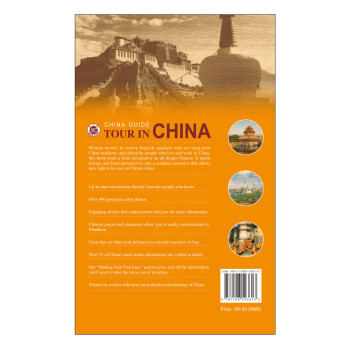- 规格参数
- 产品介绍
- 商品评价
- 包装清单
- 售后服务
- 常见问题
Wutai Shan, the Five Peaks of Serenity
Once a remote outpost reached only by the most pious of pilgrims who traveled for months with wills steeled by devotion, Wutai Shan remains a hidden treasure for those seeking true contemplation.
Wutai Shan’s name means “five terraces,” which accurately describes the five flat peaks of this sacred spot – north, east, south, west and central peak. In the quiet valleys between the peaks lie a smattering of ancient temples, twisting trails and aweinspiring views.
The major sights at Wutai Shan are rather spread out, forcing one to indulge in the gorgeous scenery that surrounds the five terraces. This also means that no one sight is overwhelmed with tour groups. Wutai Shan’s temples are an eclectic mix of Han Buddhist and Tibetan and Mongolian Lamaist traditions, making the mountain one of the best places in China to view Buddhist architecture.
The shrines on Wutai Shan date back to the Eastern Han dynasty, and the second Buddhist temple in China was built here at a time when Taoism dominated the area. A legend goes that a Buddhist monk beseeched the emperor to construct the Xiantong Temple (xiǎntōng sì 显通寺) on the mountain and suggested that a Taoist and Buddhist scroll each be put into a fire to test which religion was true. When the Taoist scroll was burned to ashes, but miraculously the Buddhist scroll remained undamaged, the temple was built. Later, Wutai Shan became a popular pilgrimage destination as more monasteries and temples were built in succeeding dynasties.
During the Sui and Tang dynasties, when Buddhism held imperial favor, over 360 temples were built. The mountain also became an international destination point for Buddhists from other countries as they were drawn to the many temples as centers of learning. Lama Buddhists began to settle on the mountain during the Qing dynasty. Today there are 47 temples and monasteries and they continue to draw devotees and curious sightseers.
Most of the temples are located around Taihuai, a small town nestling in valley 5,576 feet (1,700 m) above sea level. The temples on Wutai Shan are dedicated to Wenshu Pusa (Manjusri), the Bodhisattva of Wisdom and Virtue. A visiting Indian monk had a vision of Wenshu in the 1st century AD and concluded Wutai Shan to be the mystical abode of Buddha’s most important assistant. Numerous legends speak of how apparitions of Wenshu riding on the back of a blue lion have been sighted high above the monasteries.
ours normally begin at Taihuai; one daylong trip south of town allows you to visit several stylistically different temples. All temples share a transcendental aura, so if you’re looking to get away from the drab, mundane concerns of urban life, any temple will do.
108 carved granite steps (the same as the number of beads on a Buddhist rosary) lead to Dailuo Ding (dàiluó dǐng 黛螺顶), the temple that houses statues of five different forms of Wenshu Pusa, each of whom supposedly lives on a different peak. Legend has it that a young monk suggested statues representing the five incarnations of Wenshu be built here to save visiting emperors from a grueling trek. For those who want to visit the bodhisattvas but don’t have the time to make a house call, this is the place to ask Wutai Shan’s guardians for a blessing. To make things even easier, there’s now a cable car from the foot of Wutai Shan to the temple. Piety with convenience – if only the early pilgrims had it this easy.
Xiantong Temple is the largest and oldest temple on the mountain and is also conveniently located in the heart of town. It houses the amazing Beamless Pavilion (wúliángdiàn 无梁殿), which contains no beams and is supported through a complex set of interlocking pins. The impressive Bronze Pavilion (tóngdiàn 铜殿) is made from 110,000 pounds (50,000 kg) of bronze; it’s a perfect replica of a wooden pavilion, and the interior houses thousands of tiny Buddhas. Continuing on the bronze theme, the Youming Bell (yōumíngzhōng 幽冥钟) cast in 1620, is the largest bronze bell in the region: it’s 8.2 feet (2.5 m) high, 5.25 feet (1.6 m) across, and weighs 9999.5 jin, or 11,000 pounds (5,000 kg). A Buddhist sutra of over 10,000 Chinese characters decorates the body of the bell.
Behind the Xiantong Temple is the largest Lama temple on the mountain, the Pusa Ding (púsà dǐng 菩萨顶). Climb the 108 stairs to this temple and gaze out on the expansive views of Taihuai and the surrounding countryside. Tibetan and Mongolian Lamas stayed here during the Ming and Qing dynasties, believing that Wenshu Pusa once lived in the same place. The Wenshu Pavilion has an interesting feature: water is stored on the roof when it rains and on sunny days it drips down the roof.
The 164-foot-high (50 m) high Tibetan styled White Pagoda (bái tǎ 白塔), designed by a Nepali in 1301, has become a symbol of Wutai Shan. It stands on the grounds of Tayuan Temple (tǎyuàn sì 塔院寺), also in Taihuai. A marketplace forms around it with vendors selling incense, prayer beads, Buddhist booklets and bronze Buddhas.
Just 10 minutes away from Tayuan Temple is Shuxiang Temple (shūxiàng sì 殊像寺), which features a 20-foot-tall (6 m) statue of Wenshu riding a lion. The temple itself was last rebuilt in 1487. Take a short 10 minute walk southwest and the Puhua Temple (pǔhuá sì 普华寺) will come into view. The buildings here feature intricate carvings. About 2 miles (3 km) southwest is the South Mountain Temple (nánshān sì 南山寺) where 18 Ming dynasty statues of arhats (beings who have reached Nirvana) reside. Follow a packed earth trail down the hill for about 3 miles (5 km) and you’ll arrive at the Dragon Fountain Temple (lóngquán sì 龙泉寺), where 108 steps lead to an elaborate marble entrance with carvings of Buddhas, bodhisattvas, dragons and flowers. In the main hall is an exquisitely carved Puji Dagoba (pǔjìchánshī tǎ 普济禅师塔) with a laughing Buddha looking out from each cardinal direction. In the courtyard hundreds of small chimes tinkle in the wind.
Not far from the Tayuan Temple is the Luohou Temple (luómùhóu sì 罗目候寺); the present structures date from 1492. The temple features a unique circle altar where a lotus opens up to reveal a Buddha carved inside. The statue was made from a tree where an emperor saw a divine light. When the tree died during the Qing dynasty, it was carved into this lotus – a mechanism underground allows the lotus petals to be raised and lowered.
“在中国”系列为指南类图书,以实用、可读性强的方式呈现中国的资讯。本书为其中之一,分地区介绍了中国各地的旅游资源以及对外国人来华旅游有帮助的各种实用信息,可读性强。
Written mostly by native English speakers who are long-term China residents, and edited by people who live and work in China, this book lends a fresh perspective on all things Chinese. It melds foreign and local perspectives into a seamless narrative that allows new light to be cast on China's cities.
“知行,路更远”。怎样才能“知行”?对于自力更生的自助旅行者来说,好的方式只有一个:地图、地图,还是地图。针对旅游图书市场同类产品地图匮乏,局限于景点罗列的普遍弱点,编著团队发挥自身专业地图优势,结合数年旅游图书的制作经验,全力打造出这本《旅游指南(英文版)》(作者尤金·劳)。本书所有线路都经过超级驴友的实地勘察,所有地图都出自资深地图专家的倾力打造,所有资讯都在印前反复核实。
Written mostly by native English speakers who are long-term China residents and edited by people who live and work in China this book lends a fresh perspective on all things Chinese. It melds foreign and local perspectives into a seamless narrative that allows new light to be cast on China's cities.
CONTENTS
HISTORY & CULTURE
THE GUIDE
NORTHEAST CHINA
NORTH CHINA
NORTHWEST CHINA
EAST CHINA
CENTRAL CHINA
SOUTHWEST CHINA
SOUTH CHINA
HONG KONG, MACAU & TAIWAN
BOXED TEXT
LEARN TO SPEAK CHINESE
注:本站商品信息均来自于厂商,其真实性、准确性和合法性由信息拥有者(厂商)负责。本站不提供任何保证,并不承担任何法律责任。
由本网站发货的订单,在订单发货之前可以修改,打开“订单详情”页面,若已经出现物流信息,则表示订单无法修改。
您可以通过以下方法获取商品的到货时间:若商品页面中,显示“无货”时:商品具体的到货时间是无法确定的,您可以通过商品页面的“到货通知”功能获得商品到货提醒。
如订单处于暂停状态,进入“我的订单"页面,找到要取消的订单,点击“取消订单”按钮,若已经有物流信息,则不能取消订单。
本网站所售商品都是正品行货,均开具正规发票(图书商品用户自由选择是否开发票),发票金额含配送费金额,另有说明的除外。
在商品页面右则,您可以看到卖家信息,点击“联系客服”按钮,咨询卖家的在线客服人员,您也可以直接致电。
同个订单购买多个商品可能会分为一个以上包裹发出,可能不会同时送达,建议您耐心等待1-2天,如未收到,本网站自营商品可直接联系标准查询网在线客服。
登陆网站,进入“我的订单”,点击客户服务下的返修/退换货或商品右则的申请返修/退换货,出现返修及退换货首页,点击“申请”即可操作退换货及返修,提交成功后请耐心等待,由专业的售后工作人员受理您的申请。
一般情况下,退货处理周期(不包含检测时间):自接收到问题商品之日起 7 日之内为您处理完成,各支付方式退款时间请点击查阅退款多久可以到账; 换货处理周期:自接收到问题商品之日起 15 日之内为您处理完成。
首页 | 关于我们 | 联系我们| 友情链接| 手机商城| 企业文化| 帮助中心|
© 2016-2024 标准查询网 版权所有,并保留所有权利。联系地址: 海淀区后屯南路26号专家国际公馆5-20室 Tel: 010-62993931 E-mail: 2591325828@qq.com
ICP备案证书号 : 京ICP备09034504号






好评度